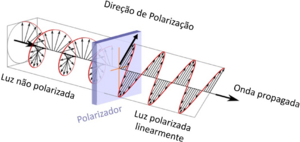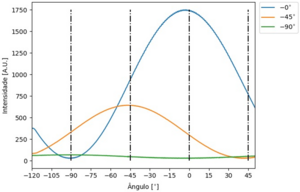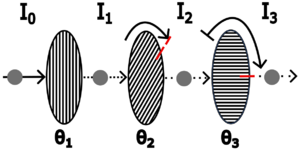Difference between revisions of "Quantum interpretation of three polarizers"
Jump to navigation
Jump to search
(Created page with "Let's describe the polarization state of light as a two-dimensional vector, as illustrated in the figure. Vertically polarized light corresponds to a vector pointing upwards (...") |
|||
| Line 9: | Line 9: | ||
〖Prob=|〈V|P_(45°) |V〉|〗^2=1/2 | 〖Prob=|〈V|P_(45°) |V〉|〗^2=1/2 | ||
</math> | </math> | ||
| + | |||
| + | |||
| + | |||
| + | [[File:Light Polarization Diagram.png|240|thumb| Expected drift in frequency when plasma is generated inside the chamber.]] | ||
| + | |||
| + | [[File:Data Analise Polaroid.png|240|thumb| Expected drift in frequency when plasma is generated inside the chamber.]] | ||
| + | |||
| + | [[File:Multi Polaroid.png|240|thumb| Expected drift in frequency when plasma is generated inside the chamber.]] | ||
| + | |||
| + | [[File:Experimental SetUp Polaroid.png|240|thumb| Expected drift in frequency when plasma is generated inside the chamber.]] | ||
Revision as of 20:59, 29 July 2024
Let's describe the polarization state of light as a two-dimensional vector, as illustrated in the figure. Vertically polarized light corresponds to a vector pointing upwards (0, 1), horizontally corresponds to (1,0). We use Dirac notation to represent these vectors, |V> and |H> respectively. An arbitrary vector is written as \(|α〉=cosα |V〉+sinα |H〉 \).
Quantum mechanics explains how to calculate: 1) the probability of transmission of these states through a polarizer, 2) the state at the exit of the polarizer. When the state \(|V>\) passes through the second polarizer, oriented at 45°, we have that: The transmission probability is given by
[math] 〖Prob=|〈V|P_(45°) |V〉|〗^2=1/2 [/math]



